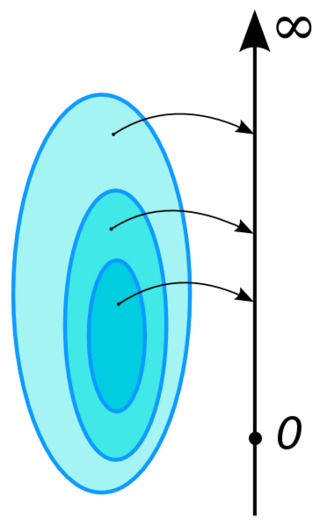热门问题
时间线
聊天
视角
測度
對一個給定集合的某些子集指定一個數的函數 来自维基百科,自由的百科全书
Remove ads
在數學中,測度是一種將幾何空間的度量(長度、面積、體積)和其他常見概念(如大小、質量和事件的概率)廣義化後產生的概念。傳統的黎曼積分是在區間上進行的,為了把積分推廣到更一般的集合上,人們就發展出測度的概念。一個特別重要的例子是勒貝格測度,它從 維歐式空間 出發,概括了傳統長度、面積和體積等等的概念。

研究測度的學問被統稱為測度論,因為指定的數值通常是非負實數,所以測度論通常會被視為實分析的一個分支,它在數學分析和概率論有重要的地位。
Remove ads
正式定義
直觀上,測度是「體積」的推廣;因為空集合的「體積」當然為零,而且互相獨立的一群(可數個)物體,總「體積」當然要是所有物體「體積」直接加總(的極限)。而要定義「體積」,必須先要決定怎樣的一群子集合,是「可以測量的」,詳細請見σ-代數。
Remove ads
若照着上述定義,根據可數可加性,不少母集合本身的測度值會變成無窮大(如對 本身取勒貝格測度),所以實際上不存在。但某些書籍[2]會形式上將無窮大視為一個數,而容許測度取值為無窮大;這樣定義的書籍,會把只容許有限實數值的測度稱為(非負)有限測度。但這樣"定義",會造成可數可加性與數列收斂的定義產生矛盾。
所以要延續體積是一種"度量"的這種直觀概念(也就是嚴謹的定義勒貝格測度),那就必須把σ-代數換成條件比較寬鬆的半集合環,然後以此為基礎去定義一個對應到"體積"的前測度。
更進一步的,如果對測度空間 來說,母集合 可表示為 內的某可測集合序列 的併集:
若 皆為有限測度集,則 會被進一步的稱為(非負)σ-有限測度。
Remove ads
性質
測度的單調性: 若和為可測集,而且,則。
Remove ads
可數個可測集的併集的測度
若為可測集(不必是兩兩不交的),則集合的併集是可測的,且有如下不等式(「次可列可加性」):
如果還滿足並且對於所有的,⊆,則如下極限式成立:
Remove ads
可數個可測集的交集的測度
若為可測集,並且對於所有的,⊆,則的交集是可測的。進一步說,如果至少一個的測度有限,則有極限:
如若不假設至少一個的測度有限,則上述性質一般不成立。例如對於每一個,令
這裏,全部集合都具有無限測度,但它們的交集是空集。
Remove ads
完備性
定義 —
是測度空間,若 且 ,則 被稱為零測集(null set )。
若所有零測集的子集都可測,則 稱為完備的(complete)。
直觀上,因為測度的單調性,只要包含於零測集的集合,也「應該」是零測集,完備測度的定義體現了這個直觀的想法。更進一步的,任意測度可以按如下的定理擴展為完備測度:[3]
Remove ads
例子
下列是一些測度的例子(順序與重要性無關)。
Remove ads
相關條目
參考文獻
外部連結
Wikiwand - on
Seamless Wikipedia browsing. On steroids.
Remove ads




































![{\displaystyle \Sigma ^{\star }:={\bigg \{}S\,{\bigg |}\,(S\subseteq X)\wedge (\exists A)(\exists B)\{(A,\,B\in \Sigma )\wedge (A\subseteq S\subseteq B)\wedge [\mu (B-A)=0]\}{\bigg \}}}](http://wikimedia.org/api/rest_v1/media/math/render/svg/9350c6a61f8fd7a24dd49edf9e34693378da3b56)

![{\displaystyle \mu ^{\star }:={\bigg \{}\langle S,\,r\rangle \,{\bigg |}\,(S\subseteq X)\wedge (\exists A)(\exists B)\{(A,\,B\in \Sigma )\wedge (A\subseteq S\subseteq B)\wedge [\mu (B-A)=0]\wedge [r=\mu (A)]\}{\bigg \}}}](http://wikimedia.org/api/rest_v1/media/math/render/svg/be8fc614426d1ecbc9ddff5def9aa67820318e31)

![{\displaystyle (\forall S\in \Sigma )[\mu ^{\star }(S)=\mu (S)]}](http://wikimedia.org/api/rest_v1/media/math/render/svg/325507b5ac2f0a3638b210cbe92e19a0718d7abc)


![{\displaystyle \mu ([0,1])=1\ }](http://wikimedia.org/api/rest_v1/media/math/render/svg/585179716417be6cf5a170cb3d9654dfe6d3039e)

